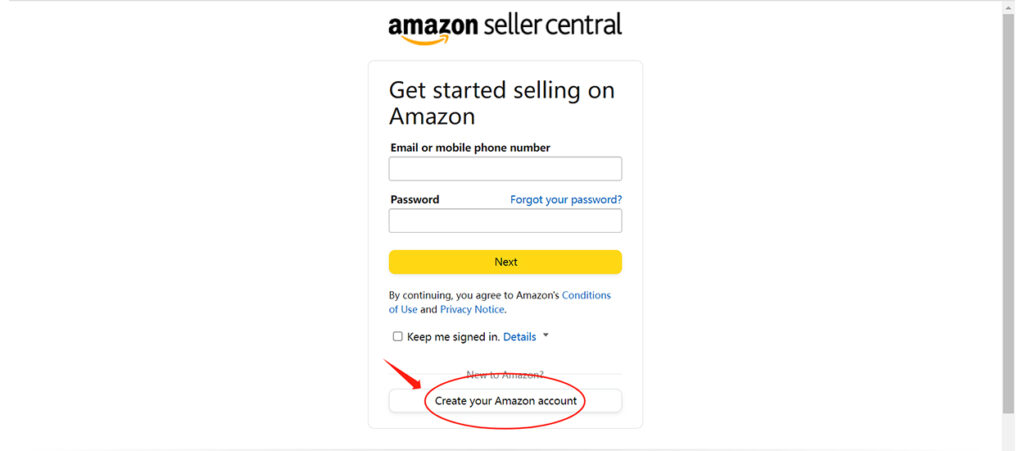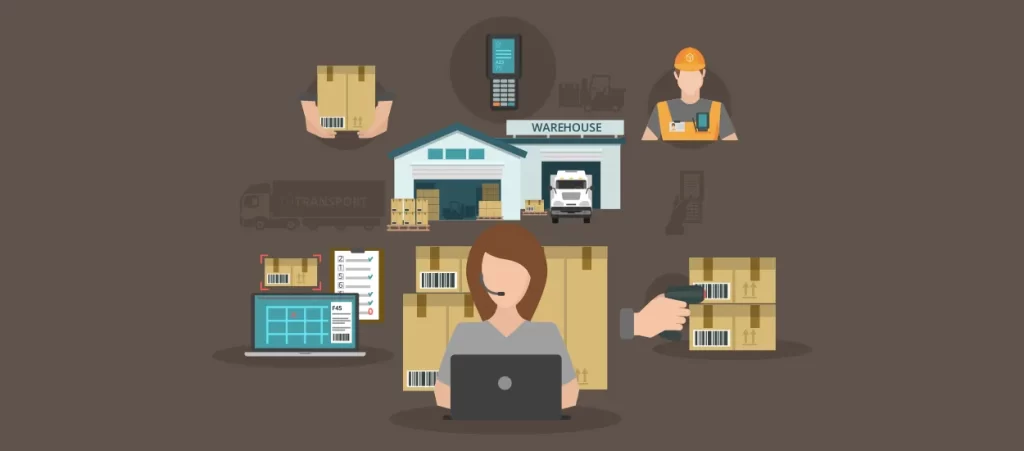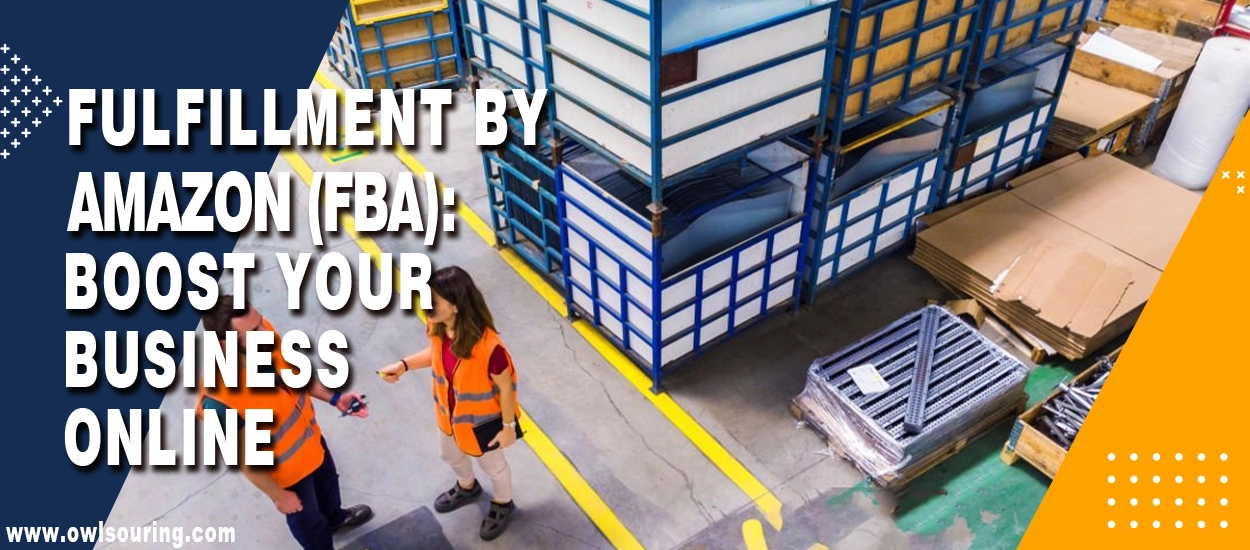Estimated reading time: 14 minutes
As you begin with the basics of Amazon selling, chances are you do not understand what Fulfillment By Amazon or, FBA refers to. You may have heard of this service by its acronym FBA, which is short for Fulfillment By Amazon.
Fulfillment by Amazon (FBA) is a service in which a seller sends inventory to the Amazon fulfillment center and Amazon will take care of picking, packing, shipping, customer service, and managing returns.
By the end of this article, we will know pretty much everything about FBA and recommendations on how to grow your business.
What Is Fulfillment By Amazon (FBA)?

Amazon FBA, which stands for ‘Fulfillment by Amazon,’ is a service whereby a merchant passes most or all of the operations of their business to Amazon.
In FBA, Customer fulfillment is done by Amazon and the FBA seller remains only responsible for the responsibility of sales and advertising, the rest including stock storage, packing, shipping, customer service, and returns are all handled by Amazon.
It assists the sellers utilize the distribution channel and customer servicing of Amazon, which might lead to an increased clientele base and early delivery.
In this case, FBA can be quite beneficial for sellers who want to direct their energy and money towards other areas of their business development and don’t need to worry about shipping their orders.
Why Choose Fulfillment By Amazon (FBA)?
Choosing Fulfillment by Amazon (FBA) for your e-commerce business offers several advantages:
- Increased Reach and Visibility: Given that Amazon currently boasts millions of active buyers, obtaining FBA guarantees the exposure of your product to millions of potential customers. Also, the minimum delivery time which makes a product eligible for Prime shipping offers you chances of clinching the Buy Box and more customers.
- Reduced Operational Burden: Given that Amazon currently boasts millions of active buyers, obtaining FBA guarantees the exposure of your product to millions of potential customers. Also, the minimum delivery time which makes a product eligible for Prime shipping offers you chances of clinching the Buy Box and more customers.
- Exceptional Customer Service: When it comes to FBA, customer questions, and complaints are dealt with specifically by the Amazon service team. This means that the customers get maximum satisfaction and this relieves the burden off your support staff.
- Scalability and Flexibility: It also enables you to expand your business without much struggle since FBA stands for Fulfilment by Amazon. So, no matter the number of products you’re selling, from a few to thousands, Amazon’s infrastructure can support the load, even when the orders are pouring in during the holiday season.
- Global Reach: This means that FBA helps sellers expand their business to other countries without worrying about shipping and customer support.
Something about: Amazon Prime

1. What is Amazon Prime?
Amazon Prime is one of the paid services given by Amazon to its users.
Here, the features include two days’ trials, free streaming services like prime videos and prime music, early and exclusive access to the shop and some goods, and finally, the best bargain along with a variety of free eBooks.
It also must be noted that exclusive of these offers, Prime members also get a first chance at special offers and discounts.
2. What Are the Benefits of Accessing Amazon Prime with FBA?
- Enhanced Customer Trust: These prime products are by default considered more trustworthy and faster due to Amazon’s customer service and delivery.
- Potential for Increased Sales: With the Prime badge, there is a high possibility of reaching out to a large number of customers subscribing to the Prime services, thus, sales might improve.
- Streamlined Operations: Under FBA, Amazon handles the shipping, customer services, and returns which can be very helpful during events like Prime Day that have a very high number of orders.
How to get started with FBA Services?
To start using Fulfillment by Amazon (FBA) services for your e-commerce business, follow these steps:
Step 1: Sign up as a seller on Amazon

New Amazon sellers must create an Amazon Seller account first if they do not have one yet. You can opt for an Individual or a Professional account depending on your operational style.
Step 2: Create Your Product Listings
To start on the process of selling your products on Amazon you will need to list your products in the Amazon catalog. Every product you intend on delivering through FBA requires a product listing in your Amazon seller account.
Step 3: Prepare Your Products for Shipment
Ensure the company’s prepared products meet the set specifications by Amazon for labelling, packaging, and getting ready for dispatch to their fulfillment centers.
Step 4: Ship Your Inventory to Amazon
Once you are done with making your products, plan their shipment in the seller account and transport your stocks directly to the Amazon fulfillment centers. Amazon will give you the shipping and routing details that you require.
Step 5: Monitor and Manage Your Inventory
You should monitor your position on the FBA dashboard in terms of inventory and restock frequently to avoid the depletion of stock in goods that sell the most.
Step 6: Monitor and Manage Your Account
It is very important to monitor sales, stock, and customer responses to review your plan and procedure.
Selecting FBA services means entrusting many aspects with the firm; however, some should be attended to.
But every seller follows some general procedures before they ship their products to amazon such as checking the quality of the product, tagging of product tags, packaging of product tags, type of packing material to be used, packing process among others.
Owlsourcing offers comprehensive services for your Amazon FBA business. If you are looking to import products from China, we can provide a one-stop Amazon FBA service from sourcing to shipping.
FBA Fees and Costs
The fulfillment cost per unit includes picking and packing your orders, shipping and handling, customer service, and product returns.
Costs are based on the weights and dimensions of your product. Shipping weight is calculated based on the item’s unit weight or dimensional weight.
From: sell.amazon
What Are the Fulfillment Fees and Other Charges Associated with FBA?
For FBA, you will be charged fulfillment fees that include picking and packing, shipping, and others such as customer service among others. These fees shall be discussed based on the size and weight of your products, and the category that the products fall under.
To determine your profit, you must learn all you need to know about fees central to using Amazon’s selling system.
Furthermore, there can be extra costs for optional services like labelling, removals, and long-term storage. Although these services may be convenient or improve your stock management, it is crucial to weigh their practicality depending on your business objectives.
The following image shows the Amazon FBA monthly inventory storage fees:

The following provides you with Amazon’s current FBA fees:
How Do FBA Storage Fees Impact Fulfillment Costs?

Storage fees are another aspect to consider when using FBA.
Amazon charges monthly storage fees based on the volume of space your inventory occupies in their fulfillment centers.
To control these costs, proper management of inventories should be done in such a way that there is not much stock in the store room as this incurs more costs in the long run.
We’ll cover this in the next part of the article: How to minimize storage fee costs?
Comparing the Costs of FBA with Other Fulfillment Methods
| Cost Factor | Fulfillment by Amazon (FBA) | Direct Fulfillment | Dropshipping |
| Inventory Storage Fees | Monthly fees are based on space used and time in storage. | Costs associated with owning or leasing a warehouse. | Typically, none, as inventory is held by suppliers. |
| Shipping Costs | Discounted shipping rates through Amazon’s network. | Depends on carrier rates, volume, and shipping distance. | Often lower, as suppliers might have preferential rates. |
| Return Handling Fees | Fees for processing returns. | Costs include labour, processing, and restocking. | Varies depend on the supplier’s policy. |
| Initial Setup Costs | Minimal, mainly shipping inventory to Amazon. | Significant – warehouse setup, purchasing inventory, etc. | Minimal, primarily for setting up an online store or platform. |
| Scaling Costs | Scalable with Amazon’s infrastructure. | Requires investment in more space, inventory, and staff. | Scalable, limited by supplier’s capacity and terms. |
| Customization and Branding | Limited options for customization and branding of packaging. | Full control over packaging and branding. | Limited, dependent on the supplier’s willingness to customize. |
| Lead Time | Fast, as Amazon prioritizes FBA shipments. | Dependent on in-house processing speed and logistics. | Dependent on the supplier’s processing and shipping times. |
While each business has unique requirements, FBA’s competitive pricing and comprehensive service offerings make it an attractive option for many e-commerce entrepreneurs.
FBA Inventory Management

Effective strategies are for that reason crucial when it comes to FBA inventory management. Here are some key considerations:
- Demand Forecasting: Sales figures and information about the market should be used to provide exact sales forecasts. It assists in keeping inventory replenishment parameters in check hence subduing storage costs and out-of-stock situations.
- Optimized Stock Placement: Fulfillment by Amazon also allows you to store your inventory in different Amazon fulfillment centers, which are tactically positioned. This makes possible faster delivery generally and less transportation expenses.
- Inventory Replenishment: Make it your responsibility to keep track of your stock base and organize an auto order so that you can run out of your popular products or keep too much of any product.
- Seasonal Planning: Seasonal variation can be accommodated by ensuring that your supply levels are in harmony with the level of demand at that time. Opt for Amazon’s storage services when dealing with the seasons which have high traffic. You should also make changes that may affect the amount of stock held as a way of preventing overstock or understock situations.
- Stay Updated on FBA Policies: The inventory is one of the critical areas that require an understanding of change in Amazon FBA policies to avoid ejection and optimize operations.
How to know about Amazon FBA’s inventory-related policy changes?

It is recommended for Amazon FBA sellers interested in relevant changes in the policies governing inventory to frequently check the Amazon Seller Central website. This platform aggregates all FBA policies that have been changed for the Amazon FBA program.
How to Avoid Stockouts and Overstocking?
Stock out tends to cost sales while on the other end overstocking leads to wastage of capital and expenditure on extra warehousing space. Here are some tips to help you strike the right balance:
- Monitor Sales Velocity: One should advise how one’s products are being sold and more specifically at what rate so that one might get an impression of the right thing to do in particular for restocking.
- Accurate Demand Forecasting: Market predictions: keep historical data on the number of products that were sold in the past, the current state of the market, and seasonality into consideration to give you a way to gauge future demand.
- Set Reorder Points: Determine the number of units to order replenished at each reorder point to incorporate lead times, the velocity of current selling, and the required safety stock. This makes sure that one restocks before the items get finished from the inventory completely.
- Implement Just-in-Time (JIT) Inventory: JIT inventory management is also advantageous because it means you do not have to keep huge quantities of merchandise on hand as you get products from your suppliers by the orders that you receive. This minimizes holding costs.
How to Deal with FBA Customer Service and Returns?

One benefit of FBA is that Amazon handles customer inquiries and complaints for them on your behalf. Here’s how it works:
- Customer Support Team: Currently, Amazon has a staff that retains a means of communication that clients can use at any one time to make inquiries on their orders, or to enquire about its return policy, refund policy, or any related issue regarding the products.
- Seller Central Dashboard: When selling on FBA, managing customer inquiries is simple through the Seller Centr interface as well. This shows a dismal picture of how customer satisfaction scores are bound to plummet for any company that will take time to respond to customer complaints.
- Proactive Communication: Let the customers know of the progress of the order and tracking details, and probably any new change on the status of the order delivery and any other form of inconvenience during the processing of the order.

Policies and Procedures Regarding Returns in FBA
All merchants experience returns as a standard occurrence in their e-commerce ventures. With FBA, the return process is streamlined, ensuring a hassle-free experience for both sellers and customers:
- Prepaid Return Labels: Customers returning FBA products get postage labels to stick on the reverse side of the package, that are paid by Amazon to make the return process easier.
- Return Processing: These are the following In addition when the returned items are brought back to Amazon’s fulfillment center, they are also checked on the state that they are in. If it’s possible, the item will be returned to its place back in inventory; if not then they will be disposed of.
- Refunds and Reimbursements: Amazon customers return products to Amazon itself and rather than receiving their money back they receive a credit to the seller’s FBA account for the qualifying products.
FBA offers great customer service, and if you incorporate this with the returns process, this will go a long way in impressing customers.
Addressing Common Challenges in FBA

Here are some solutions and best practices to overcome risks:
- Competition: This is because FBA has become mainstream; therefore, there is stiff competition out there. To be unique, pay attention to how products or services are positioned, and advertised and how well the company treats its customers.
- Pricing: Preferably offer our merchandise at a low price that can top Amazon fees. This means that consumers should be continually polled to ensure that the price you set will be able to appeal to customers.
- Inventory Performance Index (IPI): A high IPI should therefore be kept through the proper management of stocks, avoiding overstocking while at the same keeping fast-moving goods in stock.
Dealing with Seasonal Sales Fluctuations with FBA
The operations of businesses are influenced by the sales that are evident during different seasons of the year. Ensure smooth operations during peak seasons by following these tips:
- Sales Forecasting: Survey historians to have historical data from which demand during certain seasons can be predicted accurately. This means that you should increase the amounts of items you order to ensure you do not run out or order large quantities that pile up.
- Promotions and Marketing: Consequently, the promotions need to be arranged in advance to take advantage of seasonal purchase habits. I firmly believe that by using the benefits of advertising on the Amazon platform, you can achieve the highest results for your products.
- Optimize Fulfillment: As already noted, to fully meet demand in terms of inventory during the peak seasons, one may consider using other storage solutions available with Amazon.
Strategies to Minimize Long-Term Storage Fees in FBA

If not managed well, long-term storage fees can become a burden on you. Here are some strategies to minimize these expenses:
- Inventory Turnover: Optimize your inventory turnover rate by monitoring sales velocity, identifying slow-moving products, and implementing promotions or discounts to encourage sales.
- Removal Order Planning: Regularly review your inventory and consider removing items that have been stagnant to avoid long-term storage fees.
- Sell-through Strategies: Implement strategies such as bundling or offering discounted prices on slower-selling products to increase sell-through rates.
You can maximize profitability while successfully navigating the FBA environment.
Maximize Your Profits with Fulfillment by Amazon (FBA)
If you’re looking for a way to streamline your e-commerce operations, Fulfillment by Amazon (FBA) is the ultimate solution.
Whether you’re an inexperienced online seller or a seasoned business entrepreneur, being familiar with Amazon fulfillment fees and rules can help make your process smoother and increase profit.
Don’t let logistics slow you down. If you’re ready to reap the rewards of Amazon’s fulfillment program, we can help you achieve FBA fulfillment by Amazon through professional aid. Contact us today and allow us to bring your dream of e-commerce into reality!
Read More:
- Find a Manufacturer in China: How to Find Chinese Reliable Manufacturers
- Amazon FBA Sourcing Agent in China
- Warranties & Refunds When Buying From China
- Permits and Licenses When Importing from Asia
Final Thoughts
Owlsourcing provides you with Fulfillment By Amazon (FBA) sourcing and logistics services.
Upon receiving an inquiry from the sellers, our team will share a comprehensive product quotation with you. Our goal is to cut your per-unit cost by 20%-50% and make sure that you are buying only the most effective products at the least expensive rates.
From here, apart from quality control and labelling solutions, unless required we also help avail warehousing solutions in China and then ship.
Importing products from China is a wise choice, but you should be aware of the mistakes imported from China. This knowledge can help you avoid many potential issues.
If you have any questions about FBA, please feel free to contact us.
Frequently Asked Questions (FAQs)
3. Are There Any Restrictions on FBA Product Listings or Categories?
Yes, while getting on board with FBA there are certain limitations and restrictions placed on the products and categories that are restricted from selling such as hazardous products, perishable products, and products that have certain restrictions on their transportation and storage. Regarding particular policies, the reader is encouraged to visit the official site of Amazon.
4. Is Fulfillment By Amazon (FBA) Suitable for Small Businesses and Startups?
Yes, and FBA is a perfect solution for SBSs and startups, as it provides properly scalable storage and shipping services as well as helps to handle customer service inquiries for SMBs without taking much care of it.
5. How much does it cost to start Amazon FBA?
There is a vast range of different requirements, and it is difficult to determine an exact figure, for starting with Amazon FBA because it can vary depending on the number of products, their type and size, the storage and fulfilment fees as well as the costs of packaging and labelling of the products, and their transportation to the Amazon fulfilment centres.
These investments might range from $100 to a few thousand dollars. When deciding your prices for each item you sell on Amazon you should consider the cost of your stock, amazon’s fees, and any costs that come with promotions.
6. Can I Use My Own Packaging for FBA Shipments?
Of course, however, remember that your packaging for FBA shipment has to meet Amazon’s packaging requirements. These requirements are aimed at ensuring that the items are protected in the course of storage as well as the time in transit.
Amazon has a clear policy on acceptable packaging materials and how a product must be prepared and packed for order fulfilment at an FBA see more.
However, do remember that the packaging is generally not a concern for the end consumer since, generally, Amazon will repackage items in its boxes.



2 thoughts on “What is Fulfillment By Amazon (FBA)?”
Can you recommend a reliable and cost-effective fulfillment center for an Amazon FBA business based in the Canada? I am looking for a company that offers fast and accurate order processing, inventory management, and shipping services.
Thank you for your trust, Sara.
You can send an email to Info@localhost, and we will provide you with a satisfactory response.😊